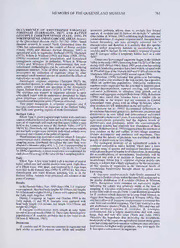
Occurrence of Sminthopsis virginiae virginiae (Tarragon, 1827) and Rattus leucopus cooktownensis (Tate, 1951) in north Queensland sugarcane areas PDF
Preview Occurrence of Sminthopsis virginiae virginiae (Tarragon, 1827) and Rattus leucopus cooktownensis (Tate, 1951) in north Queensland sugarcane areas
MEMOIRS OF THE QUEENSLAND MUSEUM 761 OCCURRENCE OF SMINTHOPSIS VIRGINIAE territories probably allows them to exclude less fecund NLVEOIURRGCTIOHNPQIUUASEEEC(NOTSOLAKARTNRODAWGSNOUENGN,ASRI1C8SA2N7(E)TAAARTNEEDA,S.R19AM5eT1mT)oiUIrSNs (csopMelacocineiAssr.attRhi.uornsor&ratdeWisid.luSss.oavnni,rdg1iM9n.6i7ab)euvreitxrohgniiibniaitraieengasnthrdiogRn.hgllfyeeuc“cru”ondpsiuetslyehcaatvneedd mofamthmealQuereensesalracnhdiMnucsoeaustmal49N(o2r)t:h7Q6u1-e7e6n2s.la2n0d04s:i-ncSematlhle clhoawraecrterfiesctiucnsdiatnyd,thaerreefolreessitsistruonnlgilkeylysethlaetcttheids sfpoercie“rs’' 1940s has concentrated on the control of Rattus sordidus would utilise temporary habitats as successfully as R. (Gould, 1858) and Melomys burtoni (Ramsay, 1887) as sordidusandM.burtoni.SowhywouldS.virginiaevirginiae (ag1r9i7c3u)l,tuWriallspoenst&s iWnhsiusgsaorcnan(e1.99R3e)dahnedadSt(o1r9y7(31),99H0i,tc1h9c9o3cak. afinedldR?. leucopus utilise a temporary habitat such as a cane rnpri(m1oooon1a9ddnvp9n9ee-eu9a3nntsl3tlabgtai)iri)teccggimiieaoadeedttnanenexlssddtnamuomamtmnlWsiehtblhtnersehieamurtodsucasedthsg.moiiorllmesiNonsopas.oedgalceint(iIineees1notsspn9.oe9pcpfcao6aiorf)tnetphisusecdblosuueearlegamtaqrssioru.tuoncaucnnasdWctsinteiieesrlsfsaa,sifcnteouhrddenloodtpwhf&iseenotvrheebrWafmryefthu,edilcuosnathctssotaihonevneon-edgrf aMVd9anua8lrd.cli9GktRenrr%noygaebaiosee1ndhf9rnctba8thllc5sleMaaoicne(nnlaakeWlrne(olethc1yoiau9anrtd!t9gv9g0te18phr)s9r0eet8a*eiV6icsnni)tndic.ig(intcocScBoefarirsSsteinhEeuaacadsSgeMviaitnea1rlhgn9clabna8fteaun5renageongldrmrbew9reee7ie7engdptn.aooec6nrlc2at%yai6nnnao1e%e9dft9ohhhoc4paaeaf)rtrnt.Hvvecheeedesrastcwtbtiireitntornhghpgte, (rpeedrS-smc.ihnecteohkmoempd.sd)iusnrnevacrhot'r,gdhieusdaseoenlvediormsgipsneeiceaienmei(nnTasirungraatrghcoeannAe.1b8e2Rr7eg)do,hwertaihdee newfuhfmiecbchterrosentuunrednaserrctr.hoswpuogrraemrsciapdnuoeepsuhlatasottithoheensp..sootileInsntucirrafelaactseoi,nighmapseraaorvpteohspiwltoairnvmte rTehgeions.peHceirmbeenrtwRaisvetrradipspterdictin(Is8u®g2a8r’cSan1e45a'd'5j0a’ceEn)titno1o9p7e2n. sroeisli-dwuaetedrecionfmiplotrsaittioino,n,tonusttriimeunltatecycclrionpg,grsoowilthaearnadtiotno, sclerophyll forest with an imderstorey dominated by blady increasesoilaggregatestrength(Robenson 1990).Robertson grass {Imperaw cylindrica). spear grass (Heteropogon (1990) also stated that ‘termites have a similar role to contortus)andkangaroograss{Themedatriandra). earthworms in the tropics and are common in Central This paper documents S. virginiae virginiae and R. Queensland crops grown w'ith no tillage techniques where leucopus cooktownensis in sugarcane in the HerbertValley cropresiduesarcleftundisturbedonthesoilsurface'. andTullycanegrowingregionsofnorthQueensland. Robertson (ct al. 1993) documented differences in invertebratefunctionalgroups(i.e.herbivores,predatorsand HerbertValley detritivores) in zero tilled and conventional cultivated ElliottTypeA.smallmammaltrapsbaitedwithcardboard agriculturalsy.stemsover5years.Itw'asnotedthatzerotillage squaresSoakedinlinseedoilweresetina40trapgrid(4cane agro-ecosystems generally had the highest levels of rowsof10trapseachwitheachtraplOniapart)withinacane detritivores and predators, while the conventionally field inthe Lannercostareaofthe Herbert Valley (IS^SS’S cultivated systems had relatively low abundances ofthese 146°0rE). Head-body,tail,hindfootandearmeasurements, groups.Robertson(etal. 1993)suggestedthattheretentionof sexandbodyweightwererecorded.Individualanimalswere crop residues on the soil surface in zero tillage situations processedandreleasedatthepointofcapture. favours decomposer and predatory soil organisms. They WeedbiomasswasassessedateachsitewhereR.leucopus found thatthe density ofpredators w'as correlated with the cooktownensisandS.virginiaevnginiaewerecollected.Five densityofdetritivoresinzerotillage. sampling points distributed throughout the cane field were The ecological diversity of an agricultural system is allocatedabiomassratingof0, 1,2.3or4correspondingto restricted compared to native habitats which have a more 7pe6r-c1e0n0ta%greegsrpeecetnicveolvye.rAexmperaesnswedeeasd0i,n1d-e2x5,w2a6s-c5a0l,c5ul1a-t7e5dafnodr cwiotmhpalegrxeaatrerradyeogrfesepoefcitersophaincdleevceolloingtiecraalctfiounnsc.tiIonnparlomgortoiunpgs eachsiteastheaverageofthevalueforthe5samplingpoints. the re-establishment of invertebrates, biodiversity will be Tully increased and with it an increase in fauna predacious on ElliottTypeAlivetrapsbaitedwithamixtureofpeanut invertebrates. Given that 5. virginiae virginiae mainly eats butter,rolledoatsandvanillaessencewereused.Eightlines insects,itfollowsthatalikelyexplanationfortheoccurrence of6 Elliott traps, 10m apart, and borderedby 6 cage traps, of this species in .sugarcane is the increased levels of were laidintheEuramoarea(18‘’0LS 145‘’52’E). Sexclass invertebrate biodiversity brought about by green cane classification and weed biomass sampling was as in the harvesting. pHoeirnbterotfcVaalplteuyr.e.Animals wereprocessedandreleasedatthe cthoemRp.praitlsceehuyacdodipisusttsirniccbtuoctooikoltnoonowyfnweiRntshsiionsrdtihidenudcsiavn(iedWuifialelslsodnaas&poppeWpahorisesedsdottnoo, Results 1993). Recaptures were common on successive nights IntheHerbertValley.Nov. 1993-June 1994,5S.virgineae indicating the colony was relatively stable at the time of wThwt8hue4eeel-iarlDgde1Tyuh-u0crtlbar5ilo6epnymdg2tgymiu-torr22inalea,endlOtnsdrgg;1Aawttm1upheh.pgeiai-ygInnDh1ghdte3sasc-d13.iI88bn6-o12RA69d.mu49ymg4gl,.ul.ees2unttagcmiholaotpnsrludees9n3wOgw-cteeh1trr1oee81bcme1acrm3pa,-tp1u1tt9rau5i9erl54demlddemiunnwrgaiittntnhhdhesg mtacafsroaanacirmndyagpeRgnulheefnirai.onfevstbgiloeht.edrelradiaRduril.nswdldbiliuorvetseweehuseewtcdsdnahopiboRipeln.uccwigshilseehcecesdyuotdceceo(slrpokWreept(ainuTtot(odsatwWrsbsniicleelo&eosnso.nsok1TAint)ishsonal&ew-sinncnadCer,Wmaonthppphs1ile9eieswr8ssseeY1foto)ewoonredrackreon1berlu9diao9ncton3smam)iuiuasa.sigyestahTasttshnbhhioltiiysteosn R leucopi1Ls cooktownensis were caught in cane fields defend territory against R. sordidus. R. leucopus devoidofin-cropweeds(Table 1).Thesecanefieldshadlow' cooktownejjsis has a largely insectivorous diet with some populationsofR.sordidus,probablyduetolowweedlevels fungi, fruit and nuts also eaten (Watts and Aslin 1981). (Wilson&Whisson, 1993). Therefore the hypothesis that increasing the invertebrate biodiversityotthesugarcaneagriculturalsystemusinggreen Discussion caneharvestingandtrashretentiontechniquesmayprovidea R.sordidusandM.burtoniarecommoninsugarcaneand foodsourceforhigherorderpredators,mayalsoapplyfor their ability to quickly colonise cane fields and establish R. leucopuscooktownensisinsugarcane. . 762 MEMOIRS OF THE QUEENSLAND MUSEUM Untilrecentlyfaunafoundinsugarcanefieldswaspoorly 1973. A reassessment ofthe rat problem in north Queensland understood. Withtheexceptionofoccasionalfaunasurveys caneficldswithemphasisontheecologyandreproductionof (Lavery&Grimes 1976)little interestwaspaidto faunain Melomysliltoralis(Lonnberg).MscThesis,JamesCookUni- oisnbudsgieacrravctaaetntiehoanttshastusgwuacarhscananosetmtohafoyseecboednaeoshmacibrciitbasetidgfnoiirfnincutahmniecser.opuuIbnslcisicpdaeectniiteoasnl ROBERQQvTeuurSeeseiOetnnNys.sl,lanaLdn..dN.Isn1u9bP9-r0bo.rcAeagenrdciihcnuglostfuortfeheaansdAuytsmhtperoaeslciiouasnmysoItfnesmttihitenutnneoorrotthhf notoriginallythoughttobeofecological significance. The AgriculturalScience,AIASOcca.sionalPublication51, 1990, registration ofagricultural chemicals, whether insecticides, pp.56-64(Norman,K.L,&Garside.A.L.eds) rodcnticides or herbicides, must be evaluated for a wider ROBERTSON,L.N.,KETTLE.B.A.&SIMPSON.G.B. 1993.The range of non-target and secondary species hazards. Soil influenceoftillagepractice.stmsoilraacrofaunainasemi-arid insecticides and fumigants interfere with the already agro-ecosy.stcm in north-eastern Australian. Agriculture, dloisssruopftseodilbifoaduinvaerdsivietrysiintyc.aTnheefibeelndesfaintsdocfoualddivreesrusletsionilllfiartuhnear STORYdE,icsoPtr.siGyc.ts.t1eB9mu9r0ae.naAduEornofvdSieurngotanmmroeEnnjitmt,oe4rr8ii,nmgepnpptr1oS4gt9ar-ta1imo5n6fsorInttheernTaullrleypoMritl.l includethepotentialtoimproveplantresiduedecomposition, 1993a.TheevaluationofKlerat®foruseAgt&msxRaUussordidusin nutrient cycling, soil aeration, soil-water infiltration, to theQueenslandsugarindustry.BureauofSugarExperiment stimulatecropgrowthandtoincreasesoilaggregatestrength StationsResearchReport93001 (Robertson, 1990). 1993b. AdditionoftheaversionagentBitrex®doesnotimpede Although the numbers of animals caught and the consumptionbyrodentsinsugarcane.BureauofSugarExperi- dseutbasielqeudelnotodkaattatahneaploypsiuslaptrieosnendtyendamheircesaorfetihnessuefftiwcoiesnptefcoiresa STRAHmmAeanNmtm.aSltRas.t.io((neAsdn.Rg)euss1e9aa9rn5cd.hRRToebhpeeorrtsctoo9nm3:p0lS0ey2td.eneyb)o.ok of Australian in relation to sugarcane production, the occurrence ofR. WATTS,C.H.S.&ASLIN,II.J. 1981.RodentsofAustralia.(Angus leucopus cooktownensis andS. virginiae vifginiae in north andRobert.son:Sydney). Queensland sugarcane fields suggest a closer look at the WHISSON, D. 1996. 'fhe effect oftwo agricultural techniques on interactionbetweenchangedagricultural techniquessuchas populaiion.softhecanefieldrat(Rattussordidus)Isugarcane rgerteeennticoann,eahnadrvensattiinvgeanAdustcrraolpiarnesifdauuenaoritsrawsahrrbalnantkeedt. WILSOcQNru,oepeJs.nso&lfanWnodHrtIhsSuQSguaOereNcna,snleDa..ndS1.u9g9W3ai.lrdlRRiofedeseeRnaetrscemhaarncaahngd2e3mD(ee5n)vt:e5l8ion9p-nm6o0er4nt.th Alterationstothebiodiversityofinvertebratesasaresultof CorporationFundingReport. sugarcane production may lead to populations of larger, WOOD.A.W. 1986. Green canetrashmanagement in the Herbert insectivorousvertebratessuchasR. leucopuscookiownensis Valley.Preliminaryresultsandresearchpriorities.Pp.86-94. mdSvirginiaevirginiaebeingsustainedinsugarcanefields. In Proceedings of the Australian Society of Sugarcane Technologists53rdConference. Acknowledgements MooIrteh,anCkSIStReOveDnivViasnioDnyokfe,WiQludeliefneslaannddEMcoulsoge>u',mAatnhedrtLoens, P8.58G,.SCtaonrbye,rAruastAraClTia2n6P0l1ag([email protected])n;,1G5P1O0B4ox for assistance in species identification and Mike Prociv, Queensland Department ofEnvironment and Heritage, for photography. This work was undertaken within research parnodgtrhaemSsufguanrdReedsbeyarthcehBaunrdeaDuevoeflSoupgmaernEtxpCoerrpiomreanttioSnt.ations TARaBtLtuEs1l.eRuecloaptuisvewmereeancawpeteurdedb.iomassincanefieldswhere References HITCHcCoOntCrKol,oBf.rEa.ts1i9n73c.anAenfieevldasl.uaPtrioocneeodfinaegrsiaolfbtahietiAnugstfroarlitahne Weedbiomassindex R.leucopuscaptured SocietyofSugarcaneTechnologists40thconferencepp59-64 August1994 0.4 0 KREBS,C.J.1985.Ecology:theexperimentalanalysisofdistribution andabundance,3rded(HarperandRow:NewYork). 2.2 0 LAVERIYn,ghHa.Jm.d&istGriRcIt,MEnSo,rthR.Qu19e7e6n,slMaanmdma1l.sInatnrdodbuicrtdisonofatnhde 0.0 11 mammals.QueenslandJournalofAgriculturalAnimalScience 0.8 0 31:383-90. MACARTHUR,R.H.&WILSON,R.O. 1967.Thetheoryofisland October1994 0.0 18 biogeography.(PrincetonLfniversityPress;Princeton). 1.2 0 REDHEAD,T.D. 1968.RodentcontrolinQueen.slandsugarcane.In ProceedingsoftheAsiaPacificInterchange,June,pp37-42.
